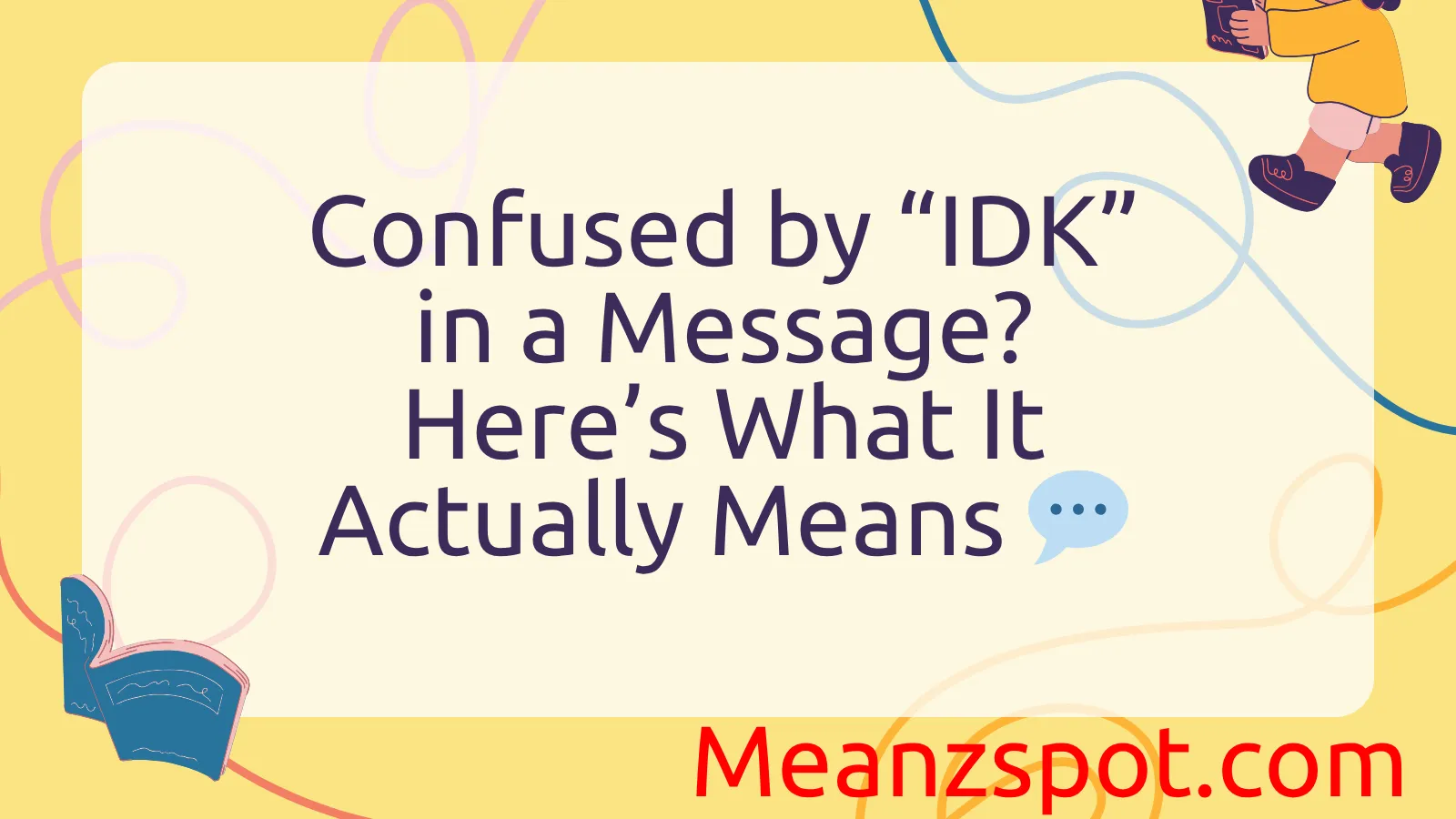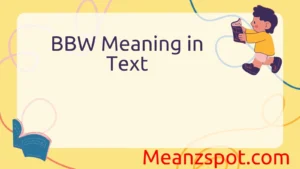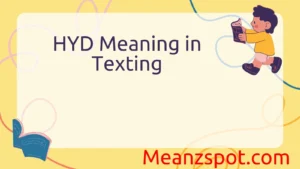Ever received a text that just says “IDK” and wondered what the person really means? Don’t worry — you’re not the only one scratching your head! In today’s fast-paced digital world of 2025, short forms like IDK are everywhere — from Snapchat and TikTok DMs to group chats and Instagram captions.
So, what does it mean? Simply put, “IDK” stands for “I Don’t Know.” It’s a super common way of saying you’re unsure about something or don’t have an answer. People use it to keep conversations casual, save time, or sometimes even to avoid giving a straight reply (yep, we’ve all been there!).
Whether it’s a chill “IDK 🤷” or a dry “idk.” — the tone can change a lot depending on context. Keep reading to learn how to interpret “IDK” in different situations, what it means across texts and social media, and how to respond without sounding awkward.
Definitions & Meaning
“IDK” is an acronym that stands for “I don’t know.” It’s a simple, concise way of expressing uncertainty, lack of knowledge, or inability to answer a question.
This abbreviation is typically used in informal digital communication, such as texting, instant messaging, and social media. It reflects casual tone and brevity, which are highly valued in digital conversations.
Example Conversations:
- Friend 1: “Do you know what time the movie starts?”
Friend 2: “IDK, probably around 7.” - Colleague: “Has the client sent the final draft yet?”
You: “IDK. I haven’t checked my email.”
The tone can vary depending on context and punctuation. “IDK.” can come across as more serious or dismissive, while “idk lol” might seem relaxed or humorous.
Because it represents a basic human response—admitting you don’t have an answer—“IDK” is one of the most versatile acronyms and is used by people of all ages, though it’s particularly common among younger demographics.
Origins & History
The phrase “I don’t know” has been a part of English speech for centuries, but the acronym “IDK” only gained widespread use with the rise of digital communication. It began appearing in online chatrooms and early instant messaging services in the late 1990s and early 2000s.
With the advent of mobile texting and platforms like AOL Instant Messenger, MSN, and later social media sites like Facebook and Twitter, the need for faster typing and character limits encouraged the development and use of abbreviations like “IDK.” As smartphones and messaging apps became more prevalent, so did these shorthand expressions.
Though it’s difficult to pinpoint exactly who coined the acronym, its emergence is part of a broader trend of internet slang that includes terms like “BRB” (Be Right Back), “LOL” (Laugh Out Loud), and “OMG” (Oh My God). Over time, “IDK” made its way into everyday language, even being spoken aloud in casual conversation among friends.
Today, “IDK” is recognized and understood by millions and is considered standard slang in the digital lexicon. It has even made its way into pop culture, meme culture, and even the verbal shorthand used in conversations.
Usage in Different Contexts
1. Social Media:
Platforms like Twitter, TikTok, and Instagram are full of quick reactions and off-the-cuff remarks. Users often post something followed by “idk” to express uncertainty or relatability. For example:
“IDK why I keep ordering iced coffee when it’s freezing outside.”
2. Text Messaging:
In texting, “IDK” is a go-to response for questions when you genuinely don’t have an answer or want to keep the conversation light:
“Where do you want to eat?”
“IDK, you pick!”
3. Online Forums and Chats:
In gaming chats, group forums, or Reddit threads, “IDK” is often used to defer to someone else or indicate you’re unsure:
“How do you beat level 10?”
“IDK, haven’t made it that far yet.”
4. Professional Communication:
Although “IDK” is informal, it occasionally sneaks into professional communication, especially in Slack channels or casual workplace chats. However, in emails or more formal exchanges, spelling out “I don’t know” is generally more appropriate.
5. Pop Culture & Memes:
“IDK” has been featured in memes, tweets, and viral content where characters or people comically throw up their hands in cluelessness. It’s also commonly paired with reaction gifs or emojis to emphasize uncertainty or playfulness.
Overall, “IDK” adapts easily to various tones—sincere, humorous, indifferent—depending on context, punctuation, and accompanying text.
Common Misunderstandings & Clarifications
Despite its simplicity, “IDK” can sometimes lead to confusion or misinterpretation, especially for those unfamiliar with texting slang or new to English.
1. Tone Misinterpretation:
“IDK” can sound dismissive or uninterested, especially in serious conversations. Without tone of voice or facial expressions, the reader may feel the sender doesn’t care. Adding clarification like “IDK, but I’ll check” can soften the message.
2. Misreading as a Typo:
For those unfamiliar with digital shorthand, “IDK” might look like a mistyped word rather than an acronym. Older generations or those learning English might need clarification.
3. Overuse in Critical Communication:
Using “IDK” in situations where a direct answer or effort is expected—like during an interview or serious meeting—can seem unprofessional or lazy. In those settings, it’s better to say, “I’m not sure, but I’ll find out.”
4. Confusion with Similar Acronyms:
“IDK” may be confused with other acronyms like “IDC” (I don’t care) or “IK” (I know), leading to mixed signals if someone reads too quickly.
Clarity often comes down to context, tone, and the relationship between the people communicating. When in doubt, it’s always fine to just write out the full phrase.
Alternatives & Synonyms
While “IDK” is the most popular acronym for expressing uncertainty, there are several alternatives and variations, both formal and informal, that convey a similar meaning:
- I’m not sure – Slightly more formal; often used in professional settings.
- No clue – Casual and sometimes humorous.
- Not sure – A simple alternative that can fit nearly any context.
- Beats me – Informal, somewhat old-school but still used.
- Who knows? – Rhetorical and playful in tone.
- I have no idea – Emphatic and expressive.
- I’m clueless – A bit self-deprecating, often used humorously.
- IDRK – A variation meaning “I don’t really know.”
- IDTS – “I don’t think so,” sometimes confused with IDK.
Each alternative has its nuances, so choosing the right one depends on the situation, audience, and level of formality.
Frequently Asked Questions (FAQ)
1. What does IDK stand for?
IDK stands for “I don’t know.”
2. Is IDK appropriate in professional settings?
Generally, it’s better to use “I don’t know” or “I’m not sure” in professional or formal conversations.
3. Can IDK be used verbally?
Yes, many people say “IDK” aloud, especially in casual settings, much like they might say “LOL.”
4. Is IDK rude?
Not inherently. However, depending on context and tone, it can seem dismissive. Adding a follow-up helps: “IDK, but I’ll look into it.”
5. What’s the difference between IDK and IDC?
“IDK” means “I don’t know,” while “IDC” means “I don’t care.” They express very different sentiments.
6. Who commonly uses IDK?
It’s widely used across all age groups but is especially common among teenagers and young adults.
7. How do you respond to someone saying IDK?
You can ask for clarification, suggest an answer, or simply move on depending on the topic.
Conclusion
Understanding acronyms like “IDK” is key to navigating today’s fast-moving digital conversations. As a simple, three-letter abbreviation for “I don’t know,” IDK has become a mainstay in text messaging, social media, and even some verbal communication. While it’s casual and convenient, it’s important to consider context and tone to avoid misunderstandings.
From its roots in early internet slang to its widespread use today, IDK exemplifies how language evolves to fit the pace and style of modern life. Whether you’re fluent in text speak or just getting started, recognizing and using IDK appropriately can help you communicate more efficiently and clearly in the digital age.



